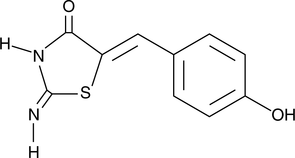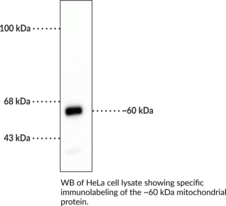Cayman
Showing 29401–29550 of 45550 results
-
Milbemycin oxime is a semi-synthetic macrocyclic lactone prepared by the oxidation and oximation of an 80:20 ratio of milbemycin A3 and A4 (Item No. 17155). Like other milbemycin/avermectins, it can potentiate glutamate and GABA-gated chloride-channel opening and is used as a nematocide and insecticide in veterinary medicine.{26993,28546}
Brand:CaymanSKU:-Out of stock
Milbemycin oxime is a semi-synthetic macrocyclic lactone prepared by the oxidation and oximation of an 80:20 ratio of milbemycin A3 and A4 (Item No. 17155). Like other milbemycin/avermectins, it can potentiate glutamate and GABA-gated chloride-channel opening and is used as a nematocide and insecticide in veterinary medicine.{26993,28546}
Brand:CaymanSKU:-Out of stock
Milbemycin oxime is a semi-synthetic macrocyclic lactone prepared by the oxidation and oximation of an 80:20 ratio of milbemycin A3 and A4 (Item No. 17155). Like other milbemycin/avermectins, it can potentiate glutamate and GABA-gated chloride-channel opening and is used as a nematocide and insecticide in veterinary medicine.{26993,28546}
Brand:CaymanSKU:-Out of stock
Mildronate is a structural analog of γ-butyrobetaine (γBB), an intermediate in the biosynthesis of carnitine. It blocks carnitine synthesis by inhibiting γBB hydroxylase (IC50 = 62 µM) and, less potently, carnitine acetyltransferase (Ki = 1.6 mM).{26111,26108,26106} Through these actions, mildronate reduces the levels of free carnitine and long chain acyl carnitine.{26110,26109} This leads to suppressed fatty acid metabolism and mitochondrial uncoupling during oxidative conditions, resulting in cardioprotective and neuroprotective effects.{26110,26109,26107} Mildronate also improves cognition and reduces amyloid-β pathology in a mouse model of Alzheimer’s disease.{26112}
Brand:CaymanSKU:-Mildronate is a structural analog of γ-butyrobetaine (γBB), an intermediate in the biosynthesis of carnitine. It blocks carnitine synthesis by inhibiting γBB hydroxylase (IC50 = 62 µM) and, less potently, carnitine acetyltransferase (Ki = 1.6 mM).{26111,26108,26106} Through these actions, mildronate reduces the levels of free carnitine and long chain acyl carnitine.{26110,26109} This leads to suppressed fatty acid metabolism and mitochondrial uncoupling during oxidative conditions, resulting in cardioprotective and neuroprotective effects.{26110,26109,26107} Mildronate also improves cognition and reduces amyloid-β pathology in a mouse model of Alzheimer’s disease.{26112}
Brand:CaymanSKU:-Mildronate is a structural analog of γ-butyrobetaine (γBB), an intermediate in the biosynthesis of carnitine. It blocks carnitine synthesis by inhibiting γBB hydroxylase (IC50 = 62 µM) and, less potently, carnitine acetyltransferase (Ki = 1.6 mM).{26111,26108,26106} Through these actions, mildronate reduces the levels of free carnitine and long chain acyl carnitine.{26110,26109} This leads to suppressed fatty acid metabolism and mitochondrial uncoupling during oxidative conditions, resulting in cardioprotective and neuroprotective effects.{26110,26109,26107} Mildronate also improves cognition and reduces amyloid-β pathology in a mouse model of Alzheimer’s disease.{26112}
Brand:CaymanSKU:-Mildronate is a structural analog of γ-butyrobetaine (γBB), an intermediate in the biosynthesis of carnitine. It blocks carnitine synthesis by inhibiting γBB hydroxylase (IC50 = 62 µM) and, less potently, carnitine acetyltransferase (Ki = 1.6 mM).{26111,26108,26106} Through these actions, mildronate reduces the levels of free carnitine and long chain acyl carnitine.{26110,26109} This leads to suppressed fatty acid metabolism and mitochondrial uncoupling during oxidative conditions, resulting in cardioprotective and neuroprotective effects.{26110,26109,26107} Mildronate also improves cognition and reduces amyloid-β pathology in a mouse model of Alzheimer’s disease.{26112}
Brand:CaymanSKU:-Milnacipran is an orally bioavailable serotonin and norepinephrine reuptake inhibitor (SNRI).{41447} It selectively inhibits the human serotonin transporter and norepinephrine transporter over the dopamine transporter (IC50s = 420, 77, and 6,100 nM, respectively). It also selectively inhibits sodium-dependent serotonin (Item No. 14332) and norepinephrine (Item No. 16673) uptake over dopamine (Item No. 21992) uptake in rat cerebral cortical synaptosomes (IC50s = 28.0, 29.6, and >10,000 nM, respectively).{41448} Milnacipran is an antagonist of the serotonin (5-HT) receptor subtype 5-HT3A as well as nicotinic acetylcholine receptors (nAChRs; IC50s = 63.5 and 14.3 μM, respectively) but does not inhibit other 5-HT, adrenergic, dopamine, muscarinic acetylcholine (mACh), histamine, NMDA, sigma, opioid, or GABA receptors (Kis = >10,000 nM).{41448,41449} In vivo, milnacipran (30 mg/kg) increases withdrawal threshold and latency in response to tactile and heat stimulation, respectively, in nerve-ligated mice.{41450} Formulations containing milnacipran have been used to treat fibromyalgia pain.
Brand:CaymanSKU:23837 - 10 mgAvailable on backorder
Milnacipran is an orally bioavailable serotonin and norepinephrine reuptake inhibitor (SNRI).{41447} It selectively inhibits the human serotonin transporter and norepinephrine transporter over the dopamine transporter (IC50s = 420, 77, and 6,100 nM, respectively). It also selectively inhibits sodium-dependent serotonin (Item No. 14332) and norepinephrine (Item No. 16673) uptake over dopamine (Item No. 21992) uptake in rat cerebral cortical synaptosomes (IC50s = 28.0, 29.6, and >10,000 nM, respectively).{41448} Milnacipran is an antagonist of the serotonin (5-HT) receptor subtype 5-HT3A as well as nicotinic acetylcholine receptors (nAChRs; IC50s = 63.5 and 14.3 μM, respectively) but does not inhibit other 5-HT, adrenergic, dopamine, muscarinic acetylcholine (mACh), histamine, NMDA, sigma, opioid, or GABA receptors (Kis = >10,000 nM).{41448,41449} In vivo, milnacipran (30 mg/kg) increases withdrawal threshold and latency in response to tactile and heat stimulation, respectively, in nerve-ligated mice.{41450} Formulations containing milnacipran have been used to treat fibromyalgia pain.
Brand:CaymanSKU:23837 - 100 mgAvailable on backorder
Milnacipran is an orally bioavailable serotonin and norepinephrine reuptake inhibitor (SNRI).{41447} It selectively inhibits the human serotonin transporter and norepinephrine transporter over the dopamine transporter (IC50s = 420, 77, and 6,100 nM, respectively). It also selectively inhibits sodium-dependent serotonin (Item No. 14332) and norepinephrine (Item No. 16673) uptake over dopamine (Item No. 21992) uptake in rat cerebral cortical synaptosomes (IC50s = 28.0, 29.6, and >10,000 nM, respectively).{41448} Milnacipran is an antagonist of the serotonin (5-HT) receptor subtype 5-HT3A as well as nicotinic acetylcholine receptors (nAChRs; IC50s = 63.5 and 14.3 μM, respectively) but does not inhibit other 5-HT, adrenergic, dopamine, muscarinic acetylcholine (mACh), histamine, NMDA, sigma, opioid, or GABA receptors (Kis = >10,000 nM).{41448,41449} In vivo, milnacipran (30 mg/kg) increases withdrawal threshold and latency in response to tactile and heat stimulation, respectively, in nerve-ligated mice.{41450} Formulations containing milnacipran have been used to treat fibromyalgia pain.
Brand:CaymanSKU:23837 - 250 mgAvailable on backorder
Milnacipran is an orally bioavailable serotonin and norepinephrine reuptake inhibitor (SNRI).{41447} It selectively inhibits the human serotonin transporter and norepinephrine transporter over the dopamine transporter (IC50s = 420, 77, and 6,100 nM, respectively). It also selectively inhibits sodium-dependent serotonin (Item No. 14332) and norepinephrine (Item No. 16673) uptake over dopamine (Item No. 21992) uptake in rat cerebral cortical synaptosomes (IC50s = 28.0, 29.6, and >10,000 nM, respectively).{41448} Milnacipran is an antagonist of the serotonin (5-HT) receptor subtype 5-HT3A as well as nicotinic acetylcholine receptors (nAChRs; IC50s = 63.5 and 14.3 μM, respectively) but does not inhibit other 5-HT, adrenergic, dopamine, muscarinic acetylcholine (mACh), histamine, NMDA, sigma, opioid, or GABA receptors (Kis = >10,000 nM).{41448,41449} In vivo, milnacipran (30 mg/kg) increases withdrawal threshold and latency in response to tactile and heat stimulation, respectively, in nerve-ligated mice.{41450} Formulations containing milnacipran have been used to treat fibromyalgia pain.
Brand:CaymanSKU:23837 - 50 mgAvailable on backorder
Milrinone is an inhibitor of type 3 phosphodiesterases (PDEs), inhibiting recombinant PDE3A and PDE3B with IC50 values of 0.45 and 1 μM, respectively.{19198} It is selective for PDE3 over PDE1, PDE2, PDE4, PDE5, and PDE7 (IC50s = 263, >300, 17.5, 49.1, and 58.3 μM, respectively).{19198} Milrinone (0.1-1 mg/kg) has positive inotropic effects, increasing cardiac contractile force in anesthetized dogs with a concomitant increase in heart rate but not blood pressure.{42416} It also increases contractile force in models of propranolol- and verapamil-induced heart failure in anesthetized dogs when administered at an initial dose of 30 µg/kg followed by a continuous 3 µg/kg per minute infusion. Milrinone has vasodilatory effects as well, decreasing mean aortic pressure and increasing venous compliance in anesthetized dogs when administered at an initial dose of 10 µg/kg followed by a continuous 1.7-2.4 µg/kg per minute infusion.{42417} Formulations containing milrinone have been used in the treatment of heart failure.
Brand:CaymanSKU:-Milrinone is an inhibitor of type 3 phosphodiesterases (PDEs), inhibiting recombinant PDE3A and PDE3B with IC50 values of 0.45 and 1 μM, respectively.{19198} It is selective for PDE3 over PDE1, PDE2, PDE4, PDE5, and PDE7 (IC50s = 263, >300, 17.5, 49.1, and 58.3 μM, respectively).{19198} Milrinone (0.1-1 mg/kg) has positive inotropic effects, increasing cardiac contractile force in anesthetized dogs with a concomitant increase in heart rate but not blood pressure.{42416} It also increases contractile force in models of propranolol- and verapamil-induced heart failure in anesthetized dogs when administered at an initial dose of 30 µg/kg followed by a continuous 3 µg/kg per minute infusion. Milrinone has vasodilatory effects as well, decreasing mean aortic pressure and increasing venous compliance in anesthetized dogs when administered at an initial dose of 10 µg/kg followed by a continuous 1.7-2.4 µg/kg per minute infusion.{42417} Formulations containing milrinone have been used in the treatment of heart failure.
Brand:CaymanSKU:-Milrinone is an inhibitor of type 3 phosphodiesterases (PDEs), inhibiting recombinant PDE3A and PDE3B with IC50 values of 0.45 and 1 μM, respectively.{19198} It is selective for PDE3 over PDE1, PDE2, PDE4, PDE5, and PDE7 (IC50s = 263, >300, 17.5, 49.1, and 58.3 μM, respectively).{19198} Milrinone (0.1-1 mg/kg) has positive inotropic effects, increasing cardiac contractile force in anesthetized dogs with a concomitant increase in heart rate but not blood pressure.{42416} It also increases contractile force in models of propranolol- and verapamil-induced heart failure in anesthetized dogs when administered at an initial dose of 30 µg/kg followed by a continuous 3 µg/kg per minute infusion. Milrinone has vasodilatory effects as well, decreasing mean aortic pressure and increasing venous compliance in anesthetized dogs when administered at an initial dose of 10 µg/kg followed by a continuous 1.7-2.4 µg/kg per minute infusion.{42417} Formulations containing milrinone have been used in the treatment of heart failure.
Brand:CaymanSKU:-Milrinone is an inhibitor of type 3 phosphodiesterases (PDEs), inhibiting recombinant PDE3A and PDE3B with IC50 values of 0.45 and 1 μM, respectively.{19198} It is selective for PDE3 over PDE1, PDE2, PDE4, PDE5, and PDE7 (IC50s = 263, >300, 17.5, 49.1, and 58.3 μM, respectively).{19198} Milrinone (0.1-1 mg/kg) has positive inotropic effects, increasing cardiac contractile force in anesthetized dogs with a concomitant increase in heart rate but not blood pressure.{42416} It also increases contractile force in models of propranolol- and verapamil-induced heart failure in anesthetized dogs when administered at an initial dose of 30 µg/kg followed by a continuous 3 µg/kg per minute infusion. Milrinone has vasodilatory effects as well, decreasing mean aortic pressure and increasing venous compliance in anesthetized dogs when administered at an initial dose of 10 µg/kg followed by a continuous 1.7-2.4 µg/kg per minute infusion.{42417} Formulations containing milrinone have been used in the treatment of heart failure.
Brand:CaymanSKU:-Miltefosine is an inhibitor of CTP:phosphocholine cytidylyl transferase and has antimetastatic properties.{6522,6526,6523} At concentrations of 3 and 25 µM, miltefosine inhibits proliferation of HaCaT cells (immortalized human keratinocyte cell line) by 50% and 94%, respectively.{6525} The mechanism of action of miltefosine is not well established, but the antiproliferative effect may be mediated by an increase in cellular ceramide which results in apoptosis. Treatment of cells with 25 µM miltefosine results in a 53% increase in ceramide concentration relative to control.{6525} Miltefosine is more than 90% effective in eradicating visceral infections of Leishmania species (kala azar), although the mechanism of this antiprotozoal activity is also poorly understood.{10433}
Brand:CaymanSKU:63280 - 1 gAvailable on backorder
Miltefosine is an inhibitor of CTP:phosphocholine cytidylyl transferase and has antimetastatic properties.{6522,6526,6523} At concentrations of 3 and 25 µM, miltefosine inhibits proliferation of HaCaT cells (immortalized human keratinocyte cell line) by 50% and 94%, respectively.{6525} The mechanism of action of miltefosine is not well established, but the antiproliferative effect may be mediated by an increase in cellular ceramide which results in apoptosis. Treatment of cells with 25 µM miltefosine results in a 53% increase in ceramide concentration relative to control.{6525} Miltefosine is more than 90% effective in eradicating visceral infections of Leishmania species (kala azar), although the mechanism of this antiprotozoal activity is also poorly understood.{10433}
Brand:CaymanSKU:63280 - 100 mgAvailable on backorder
Miltefosine is an inhibitor of CTP:phosphocholine cytidylyl transferase and has antimetastatic properties.{6522,6526,6523} At concentrations of 3 and 25 µM, miltefosine inhibits proliferation of HaCaT cells (immortalized human keratinocyte cell line) by 50% and 94%, respectively.{6525} The mechanism of action of miltefosine is not well established, but the antiproliferative effect may be mediated by an increase in cellular ceramide which results in apoptosis. Treatment of cells with 25 µM miltefosine results in a 53% increase in ceramide concentration relative to control.{6525} Miltefosine is more than 90% effective in eradicating visceral infections of Leishmania species (kala azar), although the mechanism of this antiprotozoal activity is also poorly understood.{10433}
Brand:CaymanSKU:63280 - 50 mgAvailable on backorder
Miltefosine is an inhibitor of CTP:phosphocholine cytidylyl transferase and has antimetastatic properties.{6522,6526,6523} At concentrations of 3 and 25 µM, miltefosine inhibits proliferation of HaCaT cells (immortalized human keratinocyte cell line) by 50% and 94%, respectively.{6525} The mechanism of action of miltefosine is not well established, but the antiproliferative effect may be mediated by an increase in cellular ceramide which results in apoptosis. Treatment of cells with 25 µM miltefosine results in a 53% increase in ceramide concentration relative to control.{6525} Miltefosine is more than 90% effective in eradicating visceral infections of Leishmania species (kala azar), although the mechanism of this antiprotozoal activity is also poorly understood.{10433}
Brand:CaymanSKU:63280 - 500 mgAvailable on backorder
MIM1 is an inhibitor of Mcl-1, an antiapoptotic Bcl-2 family protein with a role in cancer. It selectively engages the canonical groove of Mcl-1, inhibiting its ability to bind BH3 domains (IC50 = 4.7 µM).{32822} MIM1 induces caspase-3/7 activation and cell death in Mcl-1-dependent leukemia cells.{32822}
Brand:CaymanSKU:19832 -Available on backorder
MIM1 is an inhibitor of Mcl-1, an antiapoptotic Bcl-2 family protein with a role in cancer. It selectively engages the canonical groove of Mcl-1, inhibiting its ability to bind BH3 domains (IC50 = 4.7 µM).{32822} MIM1 induces caspase-3/7 activation and cell death in Mcl-1-dependent leukemia cells.{32822}
Brand:CaymanSKU:19832 -Available on backorder
MIM1 is an inhibitor of Mcl-1, an antiapoptotic Bcl-2 family protein with a role in cancer. It selectively engages the canonical groove of Mcl-1, inhibiting its ability to bind BH3 domains (IC50 = 4.7 µM).{32822} MIM1 induces caspase-3/7 activation and cell death in Mcl-1-dependent leukemia cells.{32822}
Brand:CaymanSKU:19832 -Available on backorder
Minoxidil is a pyrimidine derivative that was originally developed as an anti-hypertensive agent and unexpectedly found to stimulate hair growth. Minoxidil directly affects arteriolar smooth muscle to decrease vascular resistance in part by opening ATP-sensitive potassium channels.{24983,24984} It can activate cyclooxygenase 1 (AC50 = 80 μM), which is expressed in the dermal papilla of hair follicles, increasing prostaglandin E2 production in BALB/c 3T3 fibroblasts and human dermal papilla fibroblasts.{4171}
Brand:CaymanSKU:-Minoxidil is a pyrimidine derivative that was originally developed as an anti-hypertensive agent and unexpectedly found to stimulate hair growth. Minoxidil directly affects arteriolar smooth muscle to decrease vascular resistance in part by opening ATP-sensitive potassium channels.{24983,24984} It can activate cyclooxygenase 1 (AC50 = 80 μM), which is expressed in the dermal papilla of hair follicles, increasing prostaglandin E2 production in BALB/c 3T3 fibroblasts and human dermal papilla fibroblasts.{4171}
Brand:CaymanSKU:-Minoxidil is a pyrimidine derivative that was originally developed as an anti-hypertensive agent and unexpectedly found to stimulate hair growth. Minoxidil directly affects arteriolar smooth muscle to decrease vascular resistance in part by opening ATP-sensitive potassium channels.{24983,24984} It can activate cyclooxygenase 1 (AC50 = 80 μM), which is expressed in the dermal papilla of hair follicles, increasing prostaglandin E2 production in BALB/c 3T3 fibroblasts and human dermal papilla fibroblasts.{4171}
Brand:CaymanSKU:-Minoxidil is a pyrimidine derivative that was originally developed as an anti-hypertensive agent and unexpectedly found to stimulate hair growth. Minoxidil directly affects arteriolar smooth muscle to decrease vascular resistance in part by opening ATP-sensitive potassium channels.{24983,24984} It can activate cyclooxygenase 1 (AC50 = 80 μM), which is expressed in the dermal papilla of hair follicles, increasing prostaglandin E2 production in BALB/c 3T3 fibroblasts and human dermal papilla fibroblasts.{4171}
Brand:CaymanSKU:-Minoxidil-d10 contains 10 deuterium atoms on the piperidine ring. It is intended for use as an internal standard for the quantification of minoxidil (Item No. 15302) by GC- or LC-mass spectrometry. Minoxidil is a pyrimidine derivative that was originally developed as an anti-hypertensive agent and unexpectedly found to stimulate hair growth. Minoxidil directly affects arteriolar smooth muscle to decrease vascular resistance in part by opening ATP-sensitive potassium channels.{24983,24984} It can activate cyclooxygenase 1 (AC50 = 80 μM), which is expressed in the dermal papilla of hair follicles, increasing prostaglandin E2 production in BALB/c 3T3 fibroblasts and human dermal papilla fibroblasts.{4171}
Brand:CaymanSKU:-Available on backorder
Minoxidil-d10 contains 10 deuterium atoms on the piperidine ring. It is intended for use as an internal standard for the quantification of minoxidil (Item No. 15302) by GC- or LC-mass spectrometry. Minoxidil is a pyrimidine derivative that was originally developed as an anti-hypertensive agent and unexpectedly found to stimulate hair growth. Minoxidil directly affects arteriolar smooth muscle to decrease vascular resistance in part by opening ATP-sensitive potassium channels.{24983,24984} It can activate cyclooxygenase 1 (AC50 = 80 μM), which is expressed in the dermal papilla of hair follicles, increasing prostaglandin E2 production in BALB/c 3T3 fibroblasts and human dermal papilla fibroblasts.{4171}
Brand:CaymanSKU:-Available on backorder
Minoxidil-d10 contains 10 deuterium atoms on the piperidine ring. It is intended for use as an internal standard for the quantification of minoxidil (Item No. 15302) by GC- or LC-mass spectrometry. Minoxidil is a pyrimidine derivative that was originally developed as an anti-hypertensive agent and unexpectedly found to stimulate hair growth. Minoxidil directly affects arteriolar smooth muscle to decrease vascular resistance in part by opening ATP-sensitive potassium channels.{24983,24984} It can activate cyclooxygenase 1 (AC50 = 80 μM), which is expressed in the dermal papilla of hair follicles, increasing prostaglandin E2 production in BALB/c 3T3 fibroblasts and human dermal papilla fibroblasts.{4171}
Brand:CaymanSKU:-Available on backorder
Minoxidil-d10 contains 10 deuterium atoms on the piperidine ring. It is intended for use as an internal standard for the quantification of minoxidil (Item No. 15302) by GC- or LC-mass spectrometry. Minoxidil is a pyrimidine derivative that was originally developed as an anti-hypertensive agent and unexpectedly found to stimulate hair growth. Minoxidil directly affects arteriolar smooth muscle to decrease vascular resistance in part by opening ATP-sensitive potassium channels.{24983,24984} It can activate cyclooxygenase 1 (AC50 = 80 μM), which is expressed in the dermal papilla of hair follicles, increasing prostaglandin E2 production in BALB/c 3T3 fibroblasts and human dermal papilla fibroblasts.{4171}
Brand:CaymanSKU:-Available on backorder
MIRA-1 is a maleimide-derived small molecule that reactivates the tumor suppressor function of mutant p53, inducing apoptosis in several human solid tumor cell lines carrying tetracycline-regulated mutant p53 (IC50 = 10 µM in vitro).{30490} Treatment of tumor cells with MIRA-1 induces p21, MDM2 and PUMA in a mutant p53-dependent manner.{30490} At a concentration of 5-10 mg/kg, MIRA-1, alone or in combination with dexamethasone (Item No. 11015), arrested tumor growth in a mouse xenograft model of multiple myeloma.{30491}
Brand:CaymanSKU:-MIRA-1 is a maleimide-derived small molecule that reactivates the tumor suppressor function of mutant p53, inducing apoptosis in several human solid tumor cell lines carrying tetracycline-regulated mutant p53 (IC50 = 10 µM in vitro).{30490} Treatment of tumor cells with MIRA-1 induces p21, MDM2 and PUMA in a mutant p53-dependent manner.{30490} At a concentration of 5-10 mg/kg, MIRA-1, alone or in combination with dexamethasone (Item No. 11015), arrested tumor growth in a mouse xenograft model of multiple myeloma.{30491}
Brand:CaymanSKU:-Mirabegron is a β3-adrenergic receptor agonist (EC50 = 22.4 nM) that displays potent selectivity for β3 compared to the β1 and β2 receptor subtypes (EC50s ≥ 10 µM).{28306} It has been shown to relax rat and human bladder strips precontracted with carbamoylcholine (Item No. 14486) with EC50 values of 5.1 and 0.78 µM, respectively.{28306} Clinical trials have supported the efficacy of mirabegron in overactive bladder therapy.{28307}
Brand:CaymanSKU:-Available on backorder
Mirabegron is a β3-adrenergic receptor agonist (EC50 = 22.4 nM) that displays potent selectivity for β3 compared to the β1 and β2 receptor subtypes (EC50s ≥ 10 µM).{28306} It has been shown to relax rat and human bladder strips precontracted with carbamoylcholine (Item No. 14486) with EC50 values of 5.1 and 0.78 µM, respectively.{28306} Clinical trials have supported the efficacy of mirabegron in overactive bladder therapy.{28307}
Brand:CaymanSKU:-Available on backorder
Mirabegron is a β3-adrenergic receptor agonist (EC50 = 22.4 nM) that displays potent selectivity for β3 compared to the β1 and β2 receptor subtypes (EC50s ≥ 10 µM).{28306} It has been shown to relax rat and human bladder strips precontracted with carbamoylcholine (Item No. 14486) with EC50 values of 5.1 and 0.78 µM, respectively.{28306} Clinical trials have supported the efficacy of mirabegron in overactive bladder therapy.{28307}
Brand:CaymanSKU:-Available on backorder
Mirabegron is a β3-adrenergic receptor agonist (EC50 = 22.4 nM) that displays potent selectivity for β3 compared to the β1 and β2 receptor subtypes (EC50s ≥ 10 µM).{28306} It has been shown to relax rat and human bladder strips precontracted with carbamoylcholine (Item No. 14486) with EC50 values of 5.1 and 0.78 µM, respectively.{28306} Clinical trials have supported the efficacy of mirabegron in overactive bladder therapy.{28307}
Brand:CaymanSKU:-Available on backorder
The Mre11-Rad50-Nbs1 (MRN) complex acts as a DNA damage sensor, maintains genome stability during DNA replication, and activates and recruits ataxia-telangiectasia mutated (ATM) to damaged DNA. The genes that encode the MRN proteins are all essential for cell viability, so functional studies of MRN cannot involve deletion of these genes. Mirin is an inhibitor of MRN, inhibiting MRN-dependent phosphorylation of histone H2AX (IC50 = 66 μM).{16934} Through its effects on MRN, mirin prevents activation of ATM. Inhibition of MRN centers on the ability of mirin to block the nuclease activity of Mre11, rather than altering DNA-binding or MRN complex formation. In cells, mirin induces G2 arrest, abolishes the radiation-induced G2/M checkpoint, and prevents homology-directed repair of DNA damage.{16934}
Brand:CaymanSKU:-The Mre11-Rad50-Nbs1 (MRN) complex acts as a DNA damage sensor, maintains genome stability during DNA replication, and activates and recruits ataxia-telangiectasia mutated (ATM) to damaged DNA. The genes that encode the MRN proteins are all essential for cell viability, so functional studies of MRN cannot involve deletion of these genes. Mirin is an inhibitor of MRN, inhibiting MRN-dependent phosphorylation of histone H2AX (IC50 = 66 μM).{16934} Through its effects on MRN, mirin prevents activation of ATM. Inhibition of MRN centers on the ability of mirin to block the nuclease activity of Mre11, rather than altering DNA-binding or MRN complex formation. In cells, mirin induces G2 arrest, abolishes the radiation-induced G2/M checkpoint, and prevents homology-directed repair of DNA damage.{16934}
Brand:CaymanSKU:-The Mre11-Rad50-Nbs1 (MRN) complex acts as a DNA damage sensor, maintains genome stability during DNA replication, and activates and recruits ataxia-telangiectasia mutated (ATM) to damaged DNA. The genes that encode the MRN proteins are all essential for cell viability, so functional studies of MRN cannot involve deletion of these genes. Mirin is an inhibitor of MRN, inhibiting MRN-dependent phosphorylation of histone H2AX (IC50 = 66 μM).{16934} Through its effects on MRN, mirin prevents activation of ATM. Inhibition of MRN centers on the ability of mirin to block the nuclease activity of Mre11, rather than altering DNA-binding or MRN complex formation. In cells, mirin induces G2 arrest, abolishes the radiation-induced G2/M checkpoint, and prevents homology-directed repair of DNA damage.{16934}
Brand:CaymanSKU:-The Mre11-Rad50-Nbs1 (MRN) complex acts as a DNA damage sensor, maintains genome stability during DNA replication, and activates and recruits ataxia-telangiectasia mutated (ATM) to damaged DNA. The genes that encode the MRN proteins are all essential for cell viability, so functional studies of MRN cannot involve deletion of these genes. Mirin is an inhibitor of MRN, inhibiting MRN-dependent phosphorylation of histone H2AX (IC50 = 66 μM).{16934} Through its effects on MRN, mirin prevents activation of ATM. Inhibition of MRN centers on the ability of mirin to block the nuclease activity of Mre11, rather than altering DNA-binding or MRN complex formation. In cells, mirin induces G2 arrest, abolishes the radiation-induced G2/M checkpoint, and prevents homology-directed repair of DNA damage.{16934}
Brand:CaymanSKU:-Mirodenafil is a phosphodiesterase 5 (PDE5) inhibitor.{53073} It increases penile intracavernosal pressure (ICP) in a rat model of diabetes induced by streptozotocin (STZ; Item No. 13104) and in a rat model of cavernosal nerve injury when administered at doses of 1 and 10 mg/kg, respectively.{53073,53074} Mirodenafil (4 mg/kg per day) decreases bladder wall submucosal fibrosis and degeneration in a rat model of chronic bladder ischemia.{53075} It also decreases bladder overactivity in a female rat model of partial bladder outlet obstruction.{53076}
Brand:CaymanSKU:29045 - 1 mgAvailable on backorder
Mirodenafil is a phosphodiesterase 5 (PDE5) inhibitor.{53073} It increases penile intracavernosal pressure (ICP) in a rat model of diabetes induced by streptozotocin (STZ; Item No. 13104) and in a rat model of cavernosal nerve injury when administered at doses of 1 and 10 mg/kg, respectively.{53073,53074} Mirodenafil (4 mg/kg per day) decreases bladder wall submucosal fibrosis and degeneration in a rat model of chronic bladder ischemia.{53075} It also decreases bladder overactivity in a female rat model of partial bladder outlet obstruction.{53076}
Brand:CaymanSKU:29045 - 10 mgAvailable on backorder
Mirodenafil is a phosphodiesterase 5 (PDE5) inhibitor.{53073} It increases penile intracavernosal pressure (ICP) in a rat model of diabetes induced by streptozotocin (STZ; Item No. 13104) and in a rat model of cavernosal nerve injury when administered at doses of 1 and 10 mg/kg, respectively.{53073,53074} Mirodenafil (4 mg/kg per day) decreases bladder wall submucosal fibrosis and degeneration in a rat model of chronic bladder ischemia.{53075} It also decreases bladder overactivity in a female rat model of partial bladder outlet obstruction.{53076}
Brand:CaymanSKU:29045 - 5 mgAvailable on backorder
Mirogabalin is a calcium channel blocker with analgesic effects.{36068} It binds to the α2δ-1 and α2δ-2 subunits of voltage-dependent Ca2+ channels. Mirogabalin has potent and sustained analgesic effects (ED50 = 2.5 mg/kg) in rats with diabetes induced by streptozotocin (STZ; Item No. 13104). Mirogabalin does not inhibit activities associated with CNS adverse effects of analgesics, such as rotarod performance (ID50 = 9.4 mg/kg) or locomotor activity (ID50 = 43.9 mg/kg), at its effective dose. Formulations containing mirogabalin are in clinical trials for diabetic peripheral neuropathic pain.{36067}
Brand:CaymanSKU:22475 -Out of stock
Mirogabalin is a calcium channel blocker with analgesic effects.{36068} It binds to the α2δ-1 and α2δ-2 subunits of voltage-dependent Ca2+ channels. Mirogabalin has potent and sustained analgesic effects (ED50 = 2.5 mg/kg) in rats with diabetes induced by streptozotocin (STZ; Item No. 13104). Mirogabalin does not inhibit activities associated with CNS adverse effects of analgesics, such as rotarod performance (ID50 = 9.4 mg/kg) or locomotor activity (ID50 = 43.9 mg/kg), at its effective dose. Formulations containing mirogabalin are in clinical trials for diabetic peripheral neuropathic pain.{36067}
Brand:CaymanSKU:22475 -Out of stock
Misonidazole is a nitroimidazole with radiosensitizing and antineoplastic properties.{26220} Nitroimidazoles, including misonidazole, specifically accumulate as nitro anion radicals and their metabolites in hypoxic cells.{26220,26221,26223} The metabolites of misonidazole can themselves be cytotoxic or they can increase the chemosensitivity and radiosensitivity of the target cells.{26220} Misonidazole and derivatives, including fluoromisonidazole, are used in the imaging of hypoxic regions in tumors and in the cardiovascular system.{26223,26219,26222}
Brand:CaymanSKU:-Misonidazole is a nitroimidazole with radiosensitizing and antineoplastic properties.{26220} Nitroimidazoles, including misonidazole, specifically accumulate as nitro anion radicals and their metabolites in hypoxic cells.{26220,26221,26223} The metabolites of misonidazole can themselves be cytotoxic or they can increase the chemosensitivity and radiosensitivity of the target cells.{26220} Misonidazole and derivatives, including fluoromisonidazole, are used in the imaging of hypoxic regions in tumors and in the cardiovascular system.{26223,26219,26222}
Brand:CaymanSKU:-Misonidazole is a nitroimidazole with radiosensitizing and antineoplastic properties.{26220} Nitroimidazoles, including misonidazole, specifically accumulate as nitro anion radicals and their metabolites in hypoxic cells.{26220,26221,26223} The metabolites of misonidazole can themselves be cytotoxic or they can increase the chemosensitivity and radiosensitivity of the target cells.{26220} Misonidazole and derivatives, including fluoromisonidazole, are used in the imaging of hypoxic regions in tumors and in the cardiovascular system.{26223,26219,26222}
Brand:CaymanSKU:-Misonidazole is a nitroimidazole with radiosensitizing and antineoplastic properties.{26220} Nitroimidazoles, including misonidazole, specifically accumulate as nitro anion radicals and their metabolites in hypoxic cells.{26220,26221,26223} The metabolites of misonidazole can themselves be cytotoxic or they can increase the chemosensitivity and radiosensitivity of the target cells.{26220} Misonidazole and derivatives, including fluoromisonidazole, are used in the imaging of hypoxic regions in tumors and in the cardiovascular system.{26223,26219,26222}
Brand:CaymanSKU:-Misoprostol is an analog of prostaglandin E1 (PGE1; Item No. 13010) and an agonist of the PGE2 receptor subtypes EP2 and EP3.{8322,1752,59038} It binds to EP1, EP2, EP3-III, and EP4 receptors (Kis = 35.675, 10.249, 0.319, 5.499 μM, respectively) and is selective for EP receptors over DP, FP, IP, and TP receptors (Kis = >100 μM for all).{8322} Misoprostol inhibits electrically induced twitch contraction in isolated guinea pig ileum circular muscle and vas deferens (EC50s = 102.92 and 4.3 nM, respectively), which endogenously express high levels of EP2 and EP3 receptors, respectively.{59038,3411} It inhibits FMLP-induced superoxide anion generation in human neutrophils (EC50 = 0.35 μM).{1752} Misoprostol inhibits ethanol-induced gastric lesion formation in rats (ED50 = 0.31 μg/kg).{1754} Formulations containing misoprostol have been used in the prevention of NSAID-induced gastric ulcers.
Brand:CaymanSKU:-Misoprostol is an analog of prostaglandin E1 (PGE1; Item No. 13010) and an agonist of the PGE2 receptor subtypes EP2 and EP3.{8322,1752,59038} It binds to EP1, EP2, EP3-III, and EP4 receptors (Kis = 35.675, 10.249, 0.319, 5.499 μM, respectively) and is selective for EP receptors over DP, FP, IP, and TP receptors (Kis = >100 μM for all).{8322} Misoprostol inhibits electrically induced twitch contraction in isolated guinea pig ileum circular muscle and vas deferens (EC50s = 102.92 and 4.3 nM, respectively), which endogenously express high levels of EP2 and EP3 receptors, respectively.{59038,3411} It inhibits FMLP-induced superoxide anion generation in human neutrophils (EC50 = 0.35 μM).{1752} Misoprostol inhibits ethanol-induced gastric lesion formation in rats (ED50 = 0.31 μg/kg).{1754} Formulations containing misoprostol have been used in the prevention of NSAID-induced gastric ulcers.
Brand:CaymanSKU:-Misoprostol is an analog of prostaglandin E1 (PGE1; Item No. 13010) and an agonist of the PGE2 receptor subtypes EP2 and EP3.{8322,1752,59038} It binds to EP1, EP2, EP3-III, and EP4 receptors (Kis = 35.675, 10.249, 0.319, 5.499 μM, respectively) and is selective for EP receptors over DP, FP, IP, and TP receptors (Kis = >100 μM for all).{8322} Misoprostol inhibits electrically induced twitch contraction in isolated guinea pig ileum circular muscle and vas deferens (EC50s = 102.92 and 4.3 nM, respectively), which endogenously express high levels of EP2 and EP3 receptors, respectively.{59038,3411} It inhibits FMLP-induced superoxide anion generation in human neutrophils (EC50 = 0.35 μM).{1752} Misoprostol inhibits ethanol-induced gastric lesion formation in rats (ED50 = 0.31 μg/kg).{1754} Formulations containing misoprostol have been used in the prevention of NSAID-induced gastric ulcers.
Brand:CaymanSKU:-Misoprostol is an analog of prostaglandin E1 (PGE1; Item No. 13010) and an agonist of the PGE2 receptor subtypes EP2 and EP3.{8322,1752,59038} It binds to EP1, EP2, EP3-III, and EP4 receptors (Kis = 35.675, 10.249, 0.319, 5.499 μM, respectively) and is selective for EP receptors over DP, FP, IP, and TP receptors (Kis = >100 μM for all).{8322} Misoprostol inhibits electrically induced twitch contraction in isolated guinea pig ileum circular muscle and vas deferens (EC50s = 102.92 and 4.3 nM, respectively), which endogenously express high levels of EP2 and EP3 receptors, respectively.{59038,3411} It inhibits FMLP-induced superoxide anion generation in human neutrophils (EC50 = 0.35 μM).{1752} Misoprostol inhibits ethanol-induced gastric lesion formation in rats (ED50 = 0.31 μg/kg).{1754} Formulations containing misoprostol have been used in the prevention of NSAID-induced gastric ulcers.
Brand:CaymanSKU:-Misoprostol is a prostaglandin E1 (Item No. 13010) analog with agonist activity mediated by EP2, EP3, and EP4 receptors.{2313,1754,1752,1611} It has been shown to inhibit the formation of gastric lesions in rats (ED50 = 0.31 µg/kg),{1754} inhibit superoxide generation in human neutrophils (EC50 = 0.35 µM),{1752} and relax fetal rabbit ductus arteriosus (EC50 = 0.36 nM){1611} in a concentration dependent manner. Misoprostol is commonly used in clinical medicine for the prevention of peptic ulcer disease. It has also been used in conjunction with mifepristone (RU-486; Item No. 10006317) for the oral induction of first trimester abortion. Misoprostol contains a C-1 methyl ester and is readily absorbed and rapidly hydrolyzed in humans to the active free acid.{2313}
Brand:CaymanSKU:-Misoprostol is a prostaglandin E1 (Item No. 13010) analog with agonist activity mediated by EP2, EP3, and EP4 receptors.{2313,1754,1752,1611} It has been shown to inhibit the formation of gastric lesions in rats (ED50 = 0.31 µg/kg),{1754} inhibit superoxide generation in human neutrophils (EC50 = 0.35 µM),{1752} and relax fetal rabbit ductus arteriosus (EC50 = 0.36 nM){1611} in a concentration dependent manner. Misoprostol is commonly used in clinical medicine for the prevention of peptic ulcer disease. It has also been used in conjunction with mifepristone (RU-486; Item No. 10006317) for the oral induction of first trimester abortion. Misoprostol contains a C-1 methyl ester and is readily absorbed and rapidly hydrolyzed in humans to the active free acid.{2313}
Brand:CaymanSKU:-Misoprostol is a prostaglandin E1 (Item No. 13010) analog with agonist activity mediated by EP2, EP3, and EP4 receptors.{2313,1754,1752,1611} It has been shown to inhibit the formation of gastric lesions in rats (ED50 = 0.31 µg/kg),{1754} inhibit superoxide generation in human neutrophils (EC50 = 0.35 µM),{1752} and relax fetal rabbit ductus arteriosus (EC50 = 0.36 nM){1611} in a concentration dependent manner. Misoprostol is commonly used in clinical medicine for the prevention of peptic ulcer disease. It has also been used in conjunction with mifepristone (RU-486; Item No. 10006317) for the oral induction of first trimester abortion. Misoprostol contains a C-1 methyl ester and is readily absorbed and rapidly hydrolyzed in humans to the active free acid.{2313}
Brand:CaymanSKU:-Misoprostol is a prostaglandin E1 (Item No. 13010) analog with agonist activity mediated by EP2, EP3, and EP4 receptors.{2313,1754,1752,1611} It has been shown to inhibit the formation of gastric lesions in rats (ED50 = 0.31 µg/kg),{1754} inhibit superoxide generation in human neutrophils (EC50 = 0.35 µM),{1752} and relax fetal rabbit ductus arteriosus (EC50 = 0.36 nM){1611} in a concentration dependent manner. Misoprostol is commonly used in clinical medicine for the prevention of peptic ulcer disease. It has also been used in conjunction with mifepristone (RU-486; Item No. 10006317) for the oral induction of first trimester abortion. Misoprostol contains a C-1 methyl ester and is readily absorbed and rapidly hydrolyzed in humans to the active free acid.{2313}
Brand:CaymanSKU:-Misoprostol (free acid)-d5 contains five deuterium atoms at the 16 methyl, 17, and 17′ positions. It is intended for use as an internal standard for the quantification of misoprostol (free acid) by GC- or LC-mass spectrometry (MS). Misoprostol is a PGE1 analog with agonist activity mediated by EP2, EP3, and EP4 receptors.{2313,1754,1752,1611} It has been shown to inhibit the formation of gastric lesions in rats (ED50 = 0.31 µg/kg),{1754} inhibit superoxide generation in human neutrophils (EC50 = 0.35 µM),{1752} and relax fetal rabbit ductus arteriosus (EC50 = 0.36 nM){1611} in a concentration dependent manner. Misoprostol is commonly used in clinical medicine for the prevention of peptic ulcer disease. It has also been used in conjunction with RU-486 for the oral induction of first trimester abortion. Misoprostol contains a C-1 methyl ester and is readily absorbed and rapidly hydrolyzed in humans to the active free acid.{2313}
Brand:CaymanSKU:10010333 - 1 mgAvailable on backorder
Misoprostol (free acid)-d5 contains five deuterium atoms at the 16 methyl, 17, and 17′ positions. It is intended for use as an internal standard for the quantification of misoprostol (free acid) by GC- or LC-mass spectrometry (MS). Misoprostol is a PGE1 analog with agonist activity mediated by EP2, EP3, and EP4 receptors.{2313,1754,1752,1611} It has been shown to inhibit the formation of gastric lesions in rats (ED50 = 0.31 µg/kg),{1754} inhibit superoxide generation in human neutrophils (EC50 = 0.35 µM),{1752} and relax fetal rabbit ductus arteriosus (EC50 = 0.36 nM){1611} in a concentration dependent manner. Misoprostol is commonly used in clinical medicine for the prevention of peptic ulcer disease. It has also been used in conjunction with RU-486 for the oral induction of first trimester abortion. Misoprostol contains a C-1 methyl ester and is readily absorbed and rapidly hydrolyzed in humans to the active free acid.{2313}
Brand:CaymanSKU:10010333 - 100 µgAvailable on backorder
Misoprostol (free acid)-d5 contains five deuterium atoms at the 16 methyl, 17, and 17′ positions. It is intended for use as an internal standard for the quantification of misoprostol (free acid) by GC- or LC-mass spectrometry (MS). Misoprostol is a PGE1 analog with agonist activity mediated by EP2, EP3, and EP4 receptors.{2313,1754,1752,1611} It has been shown to inhibit the formation of gastric lesions in rats (ED50 = 0.31 µg/kg),{1754} inhibit superoxide generation in human neutrophils (EC50 = 0.35 µM),{1752} and relax fetal rabbit ductus arteriosus (EC50 = 0.36 nM){1611} in a concentration dependent manner. Misoprostol is commonly used in clinical medicine for the prevention of peptic ulcer disease. It has also been used in conjunction with RU-486 for the oral induction of first trimester abortion. Misoprostol contains a C-1 methyl ester and is readily absorbed and rapidly hydrolyzed in humans to the active free acid.{2313}
Brand:CaymanSKU:10010333 - 50 µgAvailable on backorder
MIT-PZR is a mitochondria-targeted fluorescent probe.{50317} It is aggregation-induced emission (AIE) active and displays absorption/emission maxima of 485/705 nm, respectively. MIT-PZR can be used in live cells and in vivo.
Brand:CaymanSKU:28925 - 1 mgAvailable on backorder
MIT-PZR is a mitochondria-targeted fluorescent probe.{50317} It is aggregation-induced emission (AIE) active and displays absorption/emission maxima of 485/705 nm, respectively. MIT-PZR can be used in live cells and in vivo.
Brand:CaymanSKU:28925 - 10 mgAvailable on backorder
MIT-PZR is a mitochondria-targeted fluorescent probe.{50317} It is aggregation-induced emission (AIE) active and displays absorption/emission maxima of 485/705 nm, respectively. MIT-PZR can be used in live cells and in vivo.
Brand:CaymanSKU:28925 - 5 mgAvailable on backorder
Mithramycin A is a DNA-binding, anti-tumor and neuroprotective antibiotic originally isolated from S. grieseus that has long been used as a chemotherapeutic agent. It mediates its protective function, in part, by regulating acetylation of histones or transcription factors and, thereby, chromatin accessibility to transcriptional machinery. As a selective Sp1 inhibitor, mithramycin A binds to GC rich DNA sequences, displacing Sp1 transcription factor binding to oncogene promoters, which inhibits their expression.{20905,20901} Mithramycin A (at 10-200 nM) can sensitize tumor cells to TRAIL-induced apoptosis and has been used to selectively target tumor cells in many different cancer models.{20904,20903,20902}
Brand:CaymanSKU:11434 - 1 mgAvailable on backorder
Mithramycin A is a DNA-binding, anti-tumor and neuroprotective antibiotic originally isolated from S. grieseus that has long been used as a chemotherapeutic agent. It mediates its protective function, in part, by regulating acetylation of histones or transcription factors and, thereby, chromatin accessibility to transcriptional machinery. As a selective Sp1 inhibitor, mithramycin A binds to GC rich DNA sequences, displacing Sp1 transcription factor binding to oncogene promoters, which inhibits their expression.{20905,20901} Mithramycin A (at 10-200 nM) can sensitize tumor cells to TRAIL-induced apoptosis and has been used to selectively target tumor cells in many different cancer models.{20904,20903,20902}
Brand:CaymanSKU:11434 - 5 mgAvailable on backorder
Mitiglinide is an inhibitor of sulfonylurea receptor 1 (SUR1) linked to ATP-sensitive potassium channel Kir6.2 (IC50 = 4 nM).{54249} It is selective for SUR1/Kir6.2 over SUR2A/Kir6.2 and SUR2B/Kir6.2 channels (IC50s = 3 and 5 µM, respectively). Mitiglinide induces insulin release in HIT-T15 insulinoma cells and isolated mouse pancreatic islets when used at a concentration of 100 µM.{54250} Oral administration of mitiglinide (1, 3, and 10 mg/kg) increases postprandial plasma insulin levels and inhibits postprandial increases in plasma glucose levels in a rat model of diabetes induced by streptozotocin (STZ; Item No. 13104).{54251}
Brand:CaymanSKU:30693 - 100 mgAvailable on backorder
Mitiglinide is an inhibitor of sulfonylurea receptor 1 (SUR1) linked to ATP-sensitive potassium channel Kir6.2 (IC50 = 4 nM).{54249} It is selective for SUR1/Kir6.2 over SUR2A/Kir6.2 and SUR2B/Kir6.2 channels (IC50s = 3 and 5 µM, respectively). Mitiglinide induces insulin release in HIT-T15 insulinoma cells and isolated mouse pancreatic islets when used at a concentration of 100 µM.{54250} Oral administration of mitiglinide (1, 3, and 10 mg/kg) increases postprandial plasma insulin levels and inhibits postprandial increases in plasma glucose levels in a rat model of diabetes induced by streptozotocin (STZ; Item No. 13104).{54251}
Brand:CaymanSKU:30693 - 250 mgAvailable on backorder
Mitiglinide is an inhibitor of sulfonylurea receptor 1 (SUR1) linked to ATP-sensitive potassium channel Kir6.2 (IC50 = 4 nM).{54249} It is selective for SUR1/Kir6.2 over SUR2A/Kir6.2 and SUR2B/Kir6.2 channels (IC50s = 3 and 5 µM, respectively). Mitiglinide induces insulin release in HIT-T15 insulinoma cells and isolated mouse pancreatic islets when used at a concentration of 100 µM.{54250} Oral administration of mitiglinide (1, 3, and 10 mg/kg) increases postprandial plasma insulin levels and inhibits postprandial increases in plasma glucose levels in a rat model of diabetes induced by streptozotocin (STZ; Item No. 13104).{54251}
Brand:CaymanSKU:30693 - 50 mgAvailable on backorder
Mitiglinide is an inhibitor of sulfonylurea receptor 1 (SUR1) linked to ATP-sensitive potassium channel Kir6.2 (IC50 = 4 nM).{54249} It is selective for SUR1/Kir6.2 over SUR2A/Kir6.2 and SUR2B/Kir6.2 channels (IC50s = 3 and 5 µM, respectively). Mitiglinide induces insulin release in HIT-T15 insulinoma cells and isolated mouse pancreatic islets when used at a concentration of 100 µM.{54250} Oral administration of mitiglinide (1, 3, and 10 mg/kg) increases postprandial plasma insulin levels and inhibits postprandial increases in plasma glucose levels in a rat model of diabetes induced by streptozotocin (STZ; Item No. 13104).{54251}
Brand:CaymanSKU:30693 - 500 mgAvailable on backorder
MitoB is a ratiometric mass spectrometry probe that can be used for assessing changes in H2O2 within mitochondria in vivo. MitoB contains a triphenylphosphonium cation component that drives its accumulation in mitochondria where its arylboronic moiety selectively reacts with H2O2 to produce a phenol product, MitoP.{27787,27786} Quantifying the MitoP/MitoB ratio by LC-MS/MS reflects the mitochondrial matrix H2O2 concentration.
Brand:CaymanSKU:-Out of stock
MitoB is a ratiometric mass spectrometry probe that can be used for assessing changes in H2O2 within mitochondria in vivo. MitoB contains a triphenylphosphonium cation component that drives its accumulation in mitochondria where its arylboronic moiety selectively reacts with H2O2 to produce a phenol product, MitoP.{27787,27786} Quantifying the MitoP/MitoB ratio by LC-MS/MS reflects the mitochondrial matrix H2O2 concentration.
Brand:CaymanSKU:-Out of stock
MitoB is a ratiometric mass spectrometry probe that can be used for assessing changes in H2O2 within mitochondria in vivo. MitoB contains a triphenylphosphonium cation component that drives its accumulation in mitochondria where its arylboronic moiety selectively reacts with H2O2 to produce a phenol product, MitoP.{27787,27786} Quantifying the MitoP/MitoB ratio by LC-MS/MS reflects the mitochondrial matrix H2O2 concentration.
Brand:CaymanSKU:-Out of stock
MitoB is a ratiometric mass spectrometry probe that can be used for assessing changes in H2O2 within mitochondria in vivo. MitoB contains a triphenylphosphonium cation component that drives its accumulation in mitochondria where its arylboronic moiety selectively reacts with H2O2 to produce a phenol product, MitoP.{27787,27786} Quantifying the MitoP/MitoB ratio by LC-MS/MS reflects the mitochondrial matrix H2O2 concentration.
Brand:CaymanSKU:-Out of stock
The condensation of the dicarboxylate oxaloacetate and acetyl CoA to the tricarboxylate citrate is catalyzed by citrate synthase. It is within this reaction that carbon molecules (as acetyl CoA) obtained from pyruvate oxidation are fed into the tricarboxylic acid (TCA or citric acid) cycle. As a mitochondrial enzyme, citrate synthase is commonly used as a normalization factor for mitochondrial protein, but can also be used as a biomarker for mitochondrial content in a tissue homogenate. Cayman’s MitoCheck® Citrate Synthase Activity Assay Kit allows for the simple and convenient determination of citrate synthase activity from isolated mitochondria, tissue, or cell homogenates. This assay measures the production of SH-CoA by monitoring the absorbance of Citrate Synthase Developing Reagent at 412 nm in a convenient 96-well format.
Brand:CaymanSKU:701040 - 96 wellsAvailable on backorder
Complex I (NADH oxidase/Co-enzyme Q reductase) is one of the major sites of electron entry into the mitochondrial electron transport chain (ETC). Complex I catalyzes the 2 electron oxidation of NADH followed by the reduction of ubiquinone (Q) to form ubiquinol (QH2), and ultimately the reduction of the terminal electron acceptor, O2. During the passage of electrons from NADH to Q, the translocation of four protons (H+) from the mitochondrial matrix to the intermembrane space occurs, contributing to the chemiosmotic proton gradient, which is required for oxidative phosphorylation. Cayman’s MitoCheck® Complex I Activity Assay allows for the activity of complex I to be determined without the need to isolate mitochondria or pre-incubate with antibodies. The rate of NADH oxidation is measured by a decrease in absorbance at 340 nm and is proportional to the activity of complex I. For the use of this kit with other types of tissue mitochondria, please see Cayman’s MitoCheck® Mitochondrial (Tissue) Isolation Kit (Item No. 701010).
Brand:CaymanSKU:700930 - 96 wellsAvailable on backorder
Complex II (succinate dehydrogenase/co-enzyme Q reductase) is one of the major sites of electron entry into the mitochondrial electron transport chain (ETC). Complex II catalyzes the oxidation of succinate to fumarate, and in the process reduces ubiquinone (Q) to ubiquinol (QH2). Ultimately, oxidation of succinate will lead to reduction of O2, the terminal step in mitochondrial respiration. Cayman’s MitoCheck® Complex II Activity Assay allows for the activity of complex II to be determined without the need to isolate mitochondria or pre-incubate with antibodies. As complex II oxidizes succinate, electrons are passed to an analog of ubiquinone and then on to DCPIP, which, when oxidized, absorbs in the 600 nm range. The absorbance of DCPIP will decrease upon reduction. Thus, Complex II activity is measured as a decrease in absorbance at 600 nm over time. For the use of this kit with other types of tissue mitochondria, please see Cayman’s MitoCheck® Mitochondrial (Tissue) Isolation Kit (Item No. 701010).
Brand:CaymanSKU:700940 - 96 wellsAvailable on backorder
Complex III (CoQ cytochrome c oxidoreductase) is an essential protein for mitochondrial oxidative phosphorylation. Complex III functions as both a gatekeeper for mitochondrial respiration and as a major source of reactive oxygen species III. It accepts electrons from complexes I and II in the form of QH2, the reduced form of the electron carrier ubiquinone. Once bound to complex III, QH2 undergoes a series of redox reactions, known as the Q-cycle. During the Q-cycle, electrons are passed from QH2 onto cytochrome c via the Rieske iron-sulfur protein and cytochrome c1 resulting in the translocation of 4H+ and the generation of 02•-. Cayman’s MitoCheck® Complex II/III Activity Assay measures the reduction of excess cytochrome c (550 nm absorbance) as catalyzed by complex III. This assay is coupled to succinate co-enzyme Q oxidoreductase (complex II) for the generation of QH2. Due to the dependence on complex II activity, a counter-screen for complex II activity (Item No. 700940) should be performed in order to truly measure complex III activity. For the use of this kit with other types of tissue mitochondria, please see Cayman’s MitoCheck® Mitochondrial (Tissue) Isolation Kit (Item No. 701010).
Brand:CaymanSKU:700950 - 96 wellsAvailable on backorder
Complex IV (cytochrome c oxidase) is the terminal electron acceptor in the mitochondrial electron transport chain. Complex IV functions by oxidizing cytochrome c and completing a four-electron reduction of oxygen (O2) to form water. During this process, two H+ are translocated from the mitochondrial matrix to the intermembrane space, contributing the mitochondrial membrane potential required for ATP synthesis. Common inhibitors of complex IV include potassium cyanide, azide, O2 limitation, nitric oxide, and carbon monoxide. Cayman’s MitoCheck® Complex IV Activity Assay is designed to measure the direct oxidation of cytochrome c by complex IV, in an isolated bovine heart mitochondrial system that is supplied within the kit. For the use of this kit with other types of tissue mitochondria, please see Cayman’s MitoCheck® Mitochondrial (Tissue) Isolation Kit (Item No. 701010).
Brand:CaymanSKU:700990 - 96 wellsAvailable on backorder
The mitochondrial F1FO ATP synthase, commonly referred to as complex V, is a multi-subunit protein that utilizes energy in the form of a proton gradient generated by the electron transport chain, to phosphorylate ADP to form ATP in the presence of Pi. This mechanism, referred to as oxidative phosphorylation, is responsible for ~90% of ATP generation in mammalian cells. Cayman’s MitoCheck® Complex V Activity Assay measures the activity of Complex V, in the reverse reaction, as an ATPase in the mitochondrial samples provided. In this assay, ATP is dephosphorylated ADP by complex V. The ADP is then utilized by pyruvate kinase to convert phosphoenolpyruvate into pyruvate with the concomitant generation of ATP. Pyruvate, in the presence of NADH and lactate dehydrogenase, is then reduced to lactate and NAD+. The rate of NADH oxidation is monitored at 340 nm. Isolated bovine heart mitochondria are provided in this kit. Tissue mitochondria can also be acquired using Cayman’s MitoCheck® Mitochondrial (Tissue) Isolation Kit (Item No. 701010).
Brand:CaymanSKU:701000 - 96 wellsAvailable on backorder
Immunogen: Human mitochondrial homogenate • Host: Mouse • Species Reactivity: (+) Human • Applications: ICC, IHC, WB • MW = ~60 kDa
Brand:CaymanSKU:29283- 100 µlMitochondria are organelles best known for their role in ATP production.{56130} They also have roles in cell cycle progression, apoptosis, carbohydrate and fatty acid catabolism, and the synthesis of steroids and other lipids. Mutations in mtDNA or nuclear genes encoding mitochondrial proteins are associated with a wide variety of human pathologies including Parkinson’s disease, Charcot-Marie-Tooth (CMT) subtype 2A, and Leber hereditary optic neuropathy (LHON).{56131,56132,56133} Cayman’s Mitochondria Monoclonal Antibody can be used for immunocytochemistry (ICC), immunohistochemistry (IHC), and Western blot (WB) applications. The antibody recognizes an undefined mitochondrial protein at approximately 60 kDa from human samples.
Brand:CaymanSKU:29283 - 100 µlAvailable on backorder



























